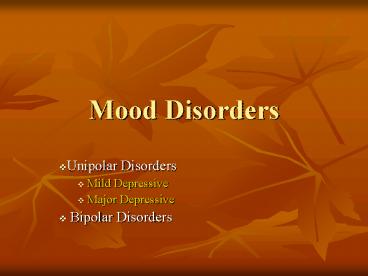Mood Disorders - PowerPoint PPT Presentation
1 / 20
Title:
Mood Disorders
Description:
In mood disorders, disturbances of mood are ... Diathesis-stress models: ... A pessimistic attribution style is a diathesis for depression. Hopelessness theory: ... – PowerPoint PPT presentation
Number of Views:63
Avg rating:3.0/5.0
Title: Mood Disorders
1
Mood Disorders
- Unipolar Disorders
- Mild Depressive
- Major Depressive
- Bipolar Disorders
2
Mood Disorders
- In mood disorders, disturbances of mood are
intense and persistent enough to be clearly
maladaptive. - The two key moods involved
- Mania
- Depression
- Unipolar Disorders
- Person experiences only severe depression.
- Bipolar Disorders
- Person experiences both manic and depressive
episodes.
3
Mood Disorders
- The lifetime prevalence of unipolar disorder
- 13 for males
- 21 for females
- The lifetime prevalence for bipolar disorder
- 0.41.6
4
Mood Disorders
- Two fairly common causes of depression that are
not considered mood disorders - Loss and the grieving process
- Postpartum blues
5
Unipolar Disorders
- The two main categories of mild to moderate
depressive disorders - Adjustment disorder with depressed mood
- Dysthymia
6
Unipolar Disorders
- Major Depressive Disorder diagnostic criteria
- That the person exhibit more symptoms than are
required for dysthymia. - That the symptoms be more persistent.
- Subtypes of major depression include
- Major depressive episode with melancholic
features. - Severe major depressive episode with psychotic
features. - Major depressive episode with atypical features.
- If major depression does not remit for more than
two years - Chronic major depressive disorder is diagnosed.
- Some people who experience recurrent depressive
episodes show a pattern commonly known as
seasonal affective disorder.
7
Unipolar Disorders
- Biological Causal Factors
- Family studies and twin studies suggest a
moderate genetic contribution. - Altered neurotransmitter activity in several
systems is clearly associated with major
depression. - The hormone cortisol also plays a role
- Depression may be linked to low levels of
activity in the left anterior or prefrontal
cortex. - Disruptions of the following may also play a
role - Sleep
- Circadian rhythms
- Exposure to sunlight
8
Unipolar Disorders
- Psychosocial Causal Factors
- Stressful life events are linked to depression.
- Diathesis-stress models
- Some people have vulnerability factors that may
increase the risk for depression. - Beck proposed a cognitive model of depression.
- Reformulated helplessness theory
- A pessimistic attribution style is a diathesis
for depression. - Hopelessness theory
- A pessimistic attribution style and one or more
negative life events will not produce depression
unless one first experiences a state of
hopelessness.
9
Bipolar Disorders
- Bipolar disorders are distinguished from unipolar
disorders by the presence of manic or hypomanic
symptoms. - Cyclothymia
- Cyclical mood swings less severe than those of
bipolar disorder.
10
Bipolar Disorders
11
Bipolar Disorders
- Schizoaffective disorder
- Period of illness during which they-
- Meet the criteria for a major mood disorder
- Exhibit at least two major symptoms of
schizophrenia - There is a greater genetic contribution to
bipolar disorder than to unipolar disorder. - Norepinephrine, serotonin, and dopamine all
appear to be involved in regulating our mood
states - Bipolar patients may have abnormalities in the
way ions are transported across the neural
membranes
12
Bipolar Disorders
- Biological Influences
- Cortisol levels
- Disturbances in biological rhythms
- Shifting patterns of blood flow to the left and
right prefrontal cortex - Psychosocial Influences
- Stressful life events
- Personality variables (such as neuroticism and
high levels of achievement striving)
13
Bipolar Disorders
- Psychotherapy
- Cognitive-behavioral therapy
- Interpersonal therapy
- Family and marital therapy
- Many patients never seek treatment, and many of
these patients will recover. - Antidepressant, mood-stabilizing, and
antipsychotic drugs are all used in the treatment
of unipolar and bipolar disorders.
14
Bipolar Disorders
- Treatment
- Antidepressant drugs usually require at least 3
to 4 weeks to take effect. - Discontinuing the drugs when symptoms have
remitted may result in a relapse. - Lithium therapy has now become widely used as a
mood stabilizer in the treatment of bipolar
disorder. - Electroconvulsive therapy is often used with
severely depressed patients.
15
Suicide
- The risk of suicide is a significant factor in
all types of depression. - Suicide ranks among the top ten leading causes of
death in most Western countries. - Suicide attempts are most common in people
between 25 and 44 years old. - Completed suicides are most common in the elderly
(65 and older). - Women are more likely to attempt suicide, but men
are more likely to complete suicide.
16
Suicide
- Rates of suicide among children seem to be
increasing. - Rates of suicides for people 1524 tripled
between the mid-1950s and mid-1980s. - Conduct disorder and substance abuse are
relatively more common among the completers of
suicide - Mood disorders are more common among nonfatal
attempters.
17
Suicide
- Causal Factors
- Genetic factors may play a role in risk for
suicide. - Reduced serotonergic activity appears to be
associated with increased risk. - Caucasian Americans have much higher rates of
suicide than African Americans. - Rates of suicide vary across cultures and
religions.
18
Suicide
- Some people do not really wish to die but instead
want to communicate a dramatic message concerning
their distress. - Research has clearly disproved the tragic belief
that those who threaten to take their lives
seldom do so.
19
Suicide
- Prevention Efforts
- Currently there are two main thrusts to
preventive efforts - Treatment of the persons current mental
disorder(s) - Crisis intervention
- Many investigators have emphasized the need for
broad-based preventive programs aimed at
alleviating the problems of people who are in
high-risk groups.
20
Suicide
- Is there a right to die?































